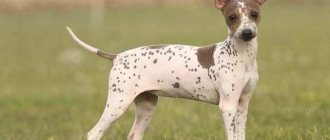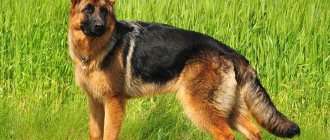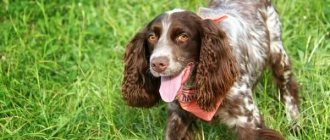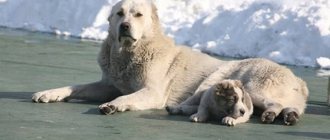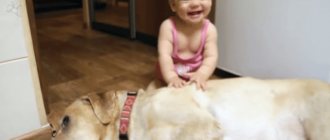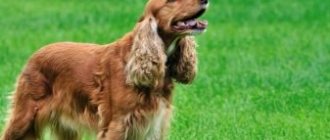Is it possible to create an animal that is as smart, dexterous and strong as a wolf, but at the same time loyal as a dog? It turns out that this is quite possible. And the Wolfhund is a dog that confirms this. This is not to say that the breed is very famous and widespread. But more and more breeders are deciding to get just such a pet.
He doesn't care about snow and frost
History of the breed
The first successful attempts to cross a dog and a wolf were made by the Dutchman Lindert Saarloos - in 1925 he created the Wulfhound breed.
Subsequently, similar attempts were made in Czechoslovakia (in 1955), where a cross between a German shepherd and a Carpathian wolf was bred, resulting in a new breed. Fact! The Czech Wolfhund is also known as the Czech Wolfdog.
Finally, already at the beginning of the twenty-first century, the Russian Wolfhund appeared, a description of the breed will be given below. When creating the breed, a she-wolf and a German shepherd were used (there is also a version that a malamute was used for this). The new breed is the largest of its kind (some believe it is a Yulan dog, but in fact they are different breeds).
Common features
Hybrids of dogs and wolves are distinguished by enviable health, they are less likely to be transmitted hereditary diseases, and their average life expectancy is much longer than that of dogs. Some of the current hybrids have been specifically bred to improve the physiological characteristics of service and working dogs.
As for appearance, wolf characteristics also prevail here: large size, thick fur of all shades of gray, good teeth. From their wild ancestors, hybrid individuals also inherit a keen sense of smell, which is at least five to six times superior to that of a dog.
There is no direct relationship between the behavior of hybrids and the amount of wolf blood they have. Even puppies from the same litter can behave differently: some act like baby dogs, others act like wolf cubs. Moreover, experienced dog handlers say: the higher the percentage of wolf blood, the more playful and curious the animal is. Therefore, the prevailing opinion that aggressiveness is an innate feature of hybrids and in certain situations they can pose a serious threat to humans has no basis. Probably, it would not make sense to crossbreed a dog and a wolf if the hybrid puppies did not inherit from one of the parents a tolerant attitude towards people and pure canine devotion to the owner.
Of course, raising a wolf dog and a lap dog are far from the same thing. And you shouldn’t have any illusions about this. Only a strong and prepared person, capable of immediately and forever establishing his leadership, can afford to adopt a wolf dog. If from the first days the puppy does not understand who is boss in the house, problems may indeed arise later.
- Cat claw attachments
- Dog
- Long-eared cats
- Cat meowing
- Alexandrian parrot
- Why does a cat need a mustache?
Therefore, more often, wolf-dog hybrids undergo targeted and intensive training in army and police units, where they are best used. The exceptional sense of smell inherent in hybrids makes them indispensable assistants in the search for explosives and drugs, in rescue operations associated with natural disasters, as well as in capturing state border violators.
Breed standard
Any officially registered breed has certain standards that regulate every little detail in the dog’s appearance. The Wolfhound is no exception.
Head
Proportional, quite powerful, shaped like a blunt wedge. The muzzle is very expressive, with a straight, not too massive nose.
Jaws and teeth
Symmetrical, with 42 firmly set teeth. Two types of bite are acceptable: scissor bite and pincer bite.
Nose
Straight, black.
Eyes
Not too big, slightly elongated. Different shades of brown are possible - from dark to amber.
Ears
Triangular in shape, firmly standing. The tips are slightly pointed.
Neck
Dry, angle relative to the back is about 40 degrees.
Frame
Rectangular, with superbly developed muscles. The back is straight, with a top line that smoothly flows into a wide, but at the same time short, barely raised croup. The chest is powerful and does not reach the elbows.
Limbs
Strong, a little closer.
Tail
Placed high. When the dog is calm, the tail is straight and slightly lowered. When active, it rises and curls slightly - shaped like a donut.
Wool
Thick and straight. There are seals on the inside of the thighs and on the neck. In winter, the coat becomes especially thick, and a powerful undercoat grows, which perfectly protects the pet from cold and wind.
Color
Acceptable colors include black, white and brown. In addition, the color can be almost all shades of the latter.
Wolfhound Kennel
This is interesting! You can sometimes hear about a blue Wolfhund, but this color has never been officially registered.
Disqualifying faults
Any deviations from the standards listed above may result in the dog being disqualified. Also a disadvantage is the discrepancy in size (both too small and huge representatives of the breed) and lack of teeth. If the Wolfhund starts barking or otherwise showing aggression, this will become a significant disadvantage.
Health
In terms of body strength, a wolf dog can compete with some half-breed mongrels, which are famous for their resistance to infections and viruses. Some are even able to survive canine distemper on their own, although such cases are rare.
The Wolfhound is not a sickly breed. His wolf ancestors rewarded their descendant with amazingly good health. The only thing you should monitor is the condition of your teeth and ears, as mentioned above. Periodic checking of the condition of the nose (it should be wet) will replace diagnostic trips to the veterinarian. Of course, if the owner is worried about his pet, once a year you can visit the clinic and make sure that your four-legged friend is in excellent health.
Education and training
The main thing in raising a Wolfhund is to be consistent and firm. From the very first months of life, the pet must understand what it can do and what it cannot do. And there should be no exceptions here. Once you show weakness, you won’t be able to win back positions.
Note! With proper training, the Wolfhound demonstrates no less discipline than the German Shepherd and other service breeds.
In training you need to show special firmness. If you do not teach commands to a puppy, then a mature, and even more so an old dog will be almost uncontrollable. This is not a terrier that can be easily picked up or pulled away if something goes wrong. A sharp mind allows the dog to quickly master commands. Combined with encouragement and sometimes punishment (sometimes this is required for particularly stubborn representatives of the breed), the pet will quickly learn at least basic commands.
Owner reviews
Andrey
The Czechoslovakian Wolfdog is not a pet for weak-willed or lazy people. Such an animal needs the firm hand of the owner; the puppy needs to be shown from childhood who is the leader in the tandem. In addition, wolfdogs need to be walked for a long time, taken on nature trips or morning jogs so that the dog uses up energy. I would not recommend buying a puppy for those who cannot devote enough time to working with it. Czech tops cannot stand loneliness and are very devoted to their owners, so you need to communicate with them as much as possible.
Denis
I have heard a lot about how Czech top dogs often show stubbornness during training and do not follow commands if they do not consider it necessary to do so. I would question this assertion, since I am not sure that dogs have the intelligence at such a level to evaluate the “need” or “unnecessity” of an order. From my own experience, I can say that dogs of this breed can simply be mischievous and stubborn, and this happens most often when the animal becomes bored or the dog gets tired. If you diversify your training and do not force your pet to constantly “fetch the wand” or monotonously perform any other exercise, there will be no problems with his training.
Jadekate
I keep it for about a week. It was not possible to buy a puppy, he is about 3 years old. An excellent security guard. Yes, you need to walk with him quite a lot and the first days were hard, but he got used to it and is already playing. As for spoiling nothing, I haven’t spoiled anything yet. Friendly to my 2nd bull terrier puppy. A strong and smart wolf. Yes, it's hard sometimes. I used to try to bite in the first days, but now I’m used to it. Yes, a wolf needs a firm hand, but once you raise it, you will see that nothing else can replace the wolf’s loyalty.
Sergey
I have been the owner of a Czech Wolfdog dog for 2 years now. I was very interested in this breed. Before I bought it I had a Rottweiler. The dog breeders I knew were very scared about his character, but I still decided. I adopted a three month old male. Of course, the appearance was frightening at first; everyone said it was a wolf. But everything turned out to be much simpler, the character is similar to a German shepherd, and is easy to train (first group FCI).
Of course, he turned out to be a wayward child, but it’s like people, everyone has a different character, he recognizes only one owner, but he treats the rest of the family very well. At 9 months he was already independently guarding his territory. Very friendly towards other dogs. Loves to chase cats and birds. The breed is little known in Russia, but is seen quite often at foreign exhibitions. Today my baby has the titles of Young Champion of Russia, Champion of Russia, Champion of Ukraine, Champion of the RKF. We will continue to continue our exhibition career. Well, I recommend this breed to everyone who wants to buy a reliable guard.
Video
Walking, physical activity and rules of safe behavior on the street
You need to walk your Wulfhound as standard, twice a day. It is advisable that one walk lasts at least an hour. At the same time, the pet must move a lot to stay in good shape. It is very important to keep him on a leash and, preferably, in a comfortable muzzle. A tall dog may well frighten someone, and at the slightest aggression from other dogs, it can rush into a fight.
The Czech Wolfdog is a relative of the Russian Wolfhund.
Maintenance and care
This breed is unpretentious and caring for it does not take much time. By nature, the dog is very clean and has no dog smell. You can keep a Wolfhund outside all year round, in an enclosure. You should not keep your dog on a chain. It should be remembered that the wolfdog is a very cunning and intelligent animal, so the yard fence should be high and solid.
Thick wool prevents dirt from settling, protects from humidity and overheating. It is worth noting that during molting, which occurs 2 times a year, the animal needs to be combed out intensively every day. A dog living on the street should be bathed 2 times a year, and the foam from the undercoat should be thoroughly washed out. Salrosa's claws wear down naturally during walking, but if the dog knocks its claws on the floor, it can be trimmed with special tongs. Check your ears for the appearance of mites and plaque; if they appear, you just need to clean them. The teeth also deserve attention; they need to be professionally cleaned in a veterinary clinic at least once every 1-2 months.
The Czech Wolfdog is one of the healthiest breeds. These dogs live longer than others. Their lifespan is 15−20 years. They are practically not exposed to diseases. By old age, these animals can develop joint dysplasia. During molting, skin diseases are possible. And you also shouldn’t skimp on medications for worms and ticks or regular visits to the veterinary clinic.
How to choose a puppy
It is very important to pay attention to the psychological state of the dog. The puppy should not be too cowardly. And if he demonstrates aggression, perhaps it makes sense to refuse the purchase - such a dog can cause a lot of problems as an adult.
On a note! According to the laws of Canada and the USA, a Wolfhund that finds itself on the street is not sent to a shelter where new owners can pick it up, but is euthanized.
Before buying, you need to examine the puppy externally - there should be no defects such as bald areas of skin or exhaustion.
Wolfhund price
It is quite difficult to buy a purebred Wolfhund in the CIS. In our regions it is not often possible to find nurseries for breeding these breeds. Although over time, Wolfhounds become popular and professional breeders began to increasingly focus on breeding these breeds.
The price of a Wolfhund can be from 50 to 120 thousand rubles , depending on the purity of the breed, age and color of the animal. Before purchasing such a dog, you need to make sure that the seller is reliable and that the accompanying documents are available.
According to reviews from professional dog breeders, Wolfhund dogs are very devoted and faithful to their owners. They have a negative attitude towards violence and shouting. Some pets are great at following the trail and can help in any search. Confined spaces have a bad effect on the dog’s general condition; frequent walks in the fresh air significantly improve the pet’s tone.
Interesting Facts
Various interesting facts about Wolfhunds are known:
- Their sense of smell is many times greater than that of a dog.
- Unlike dogs, they do not bark, but make other sounds, in a much wider range.
- As of May 2022, the breed is illegal in Finland.
He will grow into a strong and intelligent predator.
The Russian Wolfhund breed is really interesting. And even though it is not found very often in Russia yet, by getting such a dog and raising it correctly, the breeder will definitely not regret his choice.
Character
Socialization of puppies from an early age is very important. They require constant attention, communication, affection and games. Under no circumstances should they be chained.
Devotion, boundless love for the owner and unconditional submission to him - Wolfhuds received all this from the dog. They inherited good health, endurance and physical strength from the wolf.
The ability to stand up for the owner is the main character trait of a wolf dog. When you communicate with this breed for a long time, you watch wolf dogs, you understand your unconscious feelings - wolfhounds return adults to childhood. I immediately remember Jack London’s well-read book about the White Fang.
Any boy would like a dog like this. It’s so great to make friends with a real wolf and enlist his protection. Find a friend who will never offend or betray. I would like to get to know such a dog better and say: “You and I are of the same blood – you and me.”
Possible diseases and methods of treating them
Unfortunately, active and energetic large dogs often face the problem of damaged legs. While running, they may fall, dislocating or breaking a leg. If you see your pet fall unsuccessfully, we advise you to leave him in a lying position and call a veterinarian at home.
Well, if this is not possible, you will have to put a splint on the dog and transport it to the clinic yourself. If your Great Dane constantly whines and doesn't move much, he may have joint dysplasia. In this case, he will need professional help.
As additional care for your dog, give it anti-parasite medication every summer, and feed it with fresh fruits and vegetables in winter. You can also pamper your four-legged pet with non-acidic berries, such as watermelon (in season, of course).
The Great Dane is a wonderful dog. He is kind, loyal and playful. It is pleasant to interact with him, both for children and adults. Remember to systematically care for your animal to ensure its lifespan is as long as possible.
Wolfdog diseases
The Dutch breeder managed to achieve his main goal - he bred a very healthy hybrid breed of dogs with an average life expectancy of 15-16 years - this is an excellent indicator for such large dogs. No hereditary diseases have been observed in Saarlowolfhunds.
Be careful when using medications for wolfdogs
The only serious health problem for dogs of this breed is their increased susceptibility to strong medications. A course of antibiotics prescribed when necessary can result in dangerous complications for the digestive system, kidneys or liver.
Therefore, such medications should be used with great caution, always accompanying treatment with probiotics. Many wolf dogs do not tolerate anesthesia well - if anesthesia cannot be avoided, the doctor usually recommends a reduced dosage
Kinds
We already know that the main lines of this breed are considered to be the “pure” Wolfhund (Saarloos dog) and the Czech Wolfdog. The Russian breed is also in company with them. True, there are some difficulties with introducing it into a separate standard (unlike the first two, it is not yet recognized by the FCI).
Strictly speaking, it can be called a promising hybrid.
Related hybrid species (they are often confused with the base lines) include such crosses of a dog and a wolf as:
- Wolamuth;
- American Tundra Shepherd;
- Italian Lupo;
- Yulan dog;
- Kunming wolf dog;
- Canarian labito.
But let’s return to the most popular lines in our area, namely Czech and Russian. Of course, a detailed acquaintance with these dogs is unthinkable without a list of “standard” norms.
So, Czech Wolfhound:
- country : Czech Republic;
- height : 65-70 cm for males, 60-64 for females;
- weight : 26-32 kg (males), 20-27 kg (females);
- life expectancy : 12-14 years;
- shedding : abundant;
- color : basic tone - from yellowish-gray to silver, with lightening on the front of the chest and the inside of the neck. A gray mask is visible on the muzzle. Dark gray color is also allowed;
- litter : 4-6 puppies;
- purpose : pasture work, security service, companion dog;
- group : herding and cattle dogs;
- recognition : ACR, APRI, FCI.
In turn, Russian Wolfhunds (or Wolfdogs) must meet the following requirements.
- country : Russian Federation;
- height : males - 73-83 cm, females - 68-79;
- weight : 28-38 kg for males, 23-34 for females;
- life expectancy : 11-13 years;
- shedding : abundant;
- color : black, lightened on the paws, sternum and along the bottom of the body. On the sternum there is a clearly visible white mark in the form of a spot;
- litter : 3-4 puppies;
- purpose : companion dog, security service;
- group : herding and cattle dogs;
- recognition : according to the current FCI classification, it is classified as a hybrid.
Important! A long tail is considered a violation of the standard (as is a flat forehead or deep dark eye color).
Grooming and hygiene
Hygienic care for the Wolfhund is very simple.
To keep your pet looking healthy, you need to remember simple procedures, the most important of which are:
- wool cleaning. The coat is combed weekly with a special brush with soft combs. But during seasonal molting (especially spring), this has to be done 1-2 times a day, using a furminator;
- claws are trimmed extremely rarely - most often they are worn down during jogging. If such a need arises, claw clippers are used. To avoid damaging the pads, small, approximately 1 mm, sections are made;
- With teeth, everything is simple - once every 2-3 months a thorough examination of the jaws is carried out. Wolfdogs do not suffer from tartar, so there is no need for daily cleaning (although it is still worth removing stuck pieces of food);
- the eyes are wiped every day , and twice - in the morning, when the mucus accumulated during the night is removed, and in the evening (dust and dirt that got on the pupils during a walk are removed). You will need a dry cloth, it is directed from the outer edge of the eyes;
- The ears are carefully cleaned with cotton swabs. In summer - once a week, in winter - much less often (1 procedure per month is enough);
- It is enough to remove dust from the nose daily , not forgetting to check the condition of the earlobe. If it is wet during the day and a little dry in the evening, then everything is normal.
Find out what grooming is, how to choose a dog clipper, what a furminator is needed for.
Important! It is better to teach such actions from a young age: once the puppy has settled into a new place, he is introduced to basic hygiene.
Water treatments are not scary for a dog, although it is advisable to keep them to a minimum - a proud Wolfhund will perceive transferring them to a bathtub or placing them in a basin almost as violence. Therefore, thorough washing is carried out only in cases of extreme necessity (with minimal participation of special cosmetics).
Otherwise, hygienic manipulations boil down to daily inspection of the paw pads and removal of dirt from them, monitoring the health of the eyes, nose and earlobes (checking for foreign fragments).

